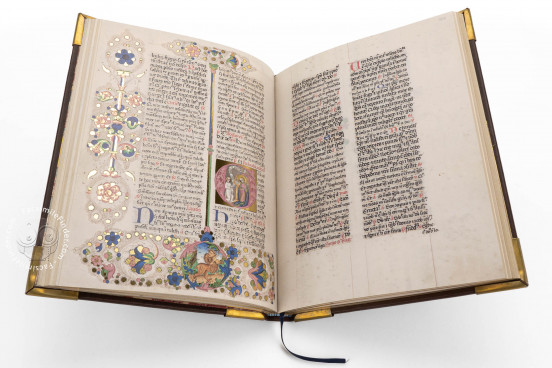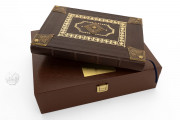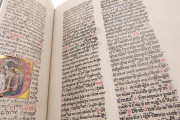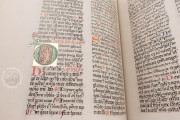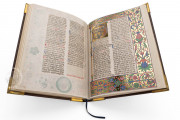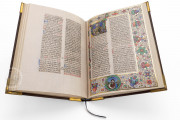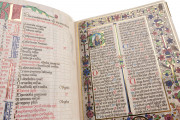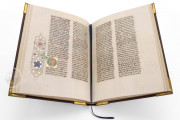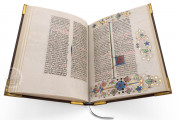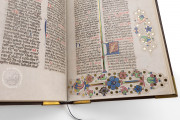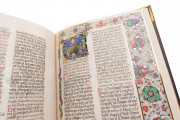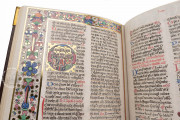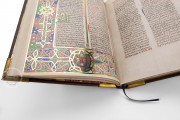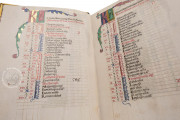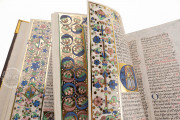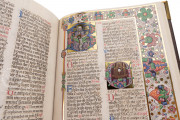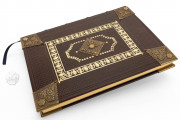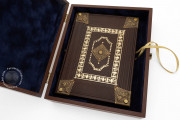The Kálmáncsehi–Liechtenstein Codex is a richly illuminated Christian liturgical book comprising a calandar, a breviary, and a missal. Produced in Buda and dated 1481, it was made for the humanist Domonkos Kálmáncsehi, later bishop of Transylvania and Kalocsa. The illumination is by several Hungarian artists influenced by the style of Francesco da Castello of Milan. The manuscript features a full-page miniature of the Crucifixion and forty-eight historiated initials, most on pages with elaborate painted borders, some featuring grotesques, coats of arms, and medallions.
Historical Significance of the Kálmáncsehi-Lichtenstein Codex
The Kálmáncsehi-Lichtenstein Codex stands as an important monument of Hungarian medieval culture. Originating from the personal codex of Domonkos Kálmáncsehi, provost of the coronation church in Székesfehérvár, this richly ornamented manuscript today resides in New York, geographically and culturally distant from the context in which it was created.
Material Composition and Liturgical Function
Crafted on parchment, the codex was designed to support the prelate in his liturgical and devotional duties. Its first half functions as a breviary, a prayer book used by priests, while the second half serves as a mass book. At the beginning of the volume, a calendar outlines the sequence of feasts throughout the church year. The manuscript’s compact format, together with the integration of two distinct liturgical texts into a single volume, suggests that Domonkos Kálmáncsehi likely employed the codex during his travels.
Cultural Context of Late Fifteenth-Century Hungary
The manuscript reflects the dynamism of a transformative historical moment. The 1480s were a decisive decade in late fifteenth-century Hungary, a period shaped by the convergence of inherited medieval traditions and emerging Renaissance aspirations. By this time, the evolving cultural landscape had given rise to what is often described as the Hungarian Renaissance. During these years, King Matthias Hunyadi (1458–1490) occupied Vienna, commissioned the construction of royal residences, and oversaw the creation of the celebrated Bibliotheca Corvina.
Hungarian cultural life became increasingly aligned with the Italian Renaissance, attracting architects, sculptors, carpenters, manuscript illuminators, bookbinders, musicians, astronomers, jurists, historians, and other humanists to the kingdom. Initiatives launched during this era would continue to shape Hungarian cultural development for generations.
The Royal Workshop in Buda and the Codex’s Artistic Style
The book-producing workshop in Buda served both the royal library and leading ecclesiastical figures. The Kálmáncsehi codex was produced in this royal workshop, and its decoration is of particular interest: many of its motifs draw upon manuscripts created for the Royal Library, which featured the work of distinguished Italian illuminators. Closer analysis of the ornamental pages reveals a nuanced interplay between Italian Renaissance decorative principles and Central European Gothic book-painting traditions. This synthesis is evident in the elongated, pointed leaves with delicate tendrils, as well as the predominantly Gothic initials throughout the breviary. Together, these features illustrate the creative fusion of imported Renaissance aesthetics with local artistic conventions.
We have 1 facsimile edition of the manuscript "Kálmáncsehi-Liechtenstein Codex": Kálmáncsehi-Liechtenstein Breviary and Missal facsimile edition, published by Schöck ArtPrint Kft., 2021
Request Info / Price
